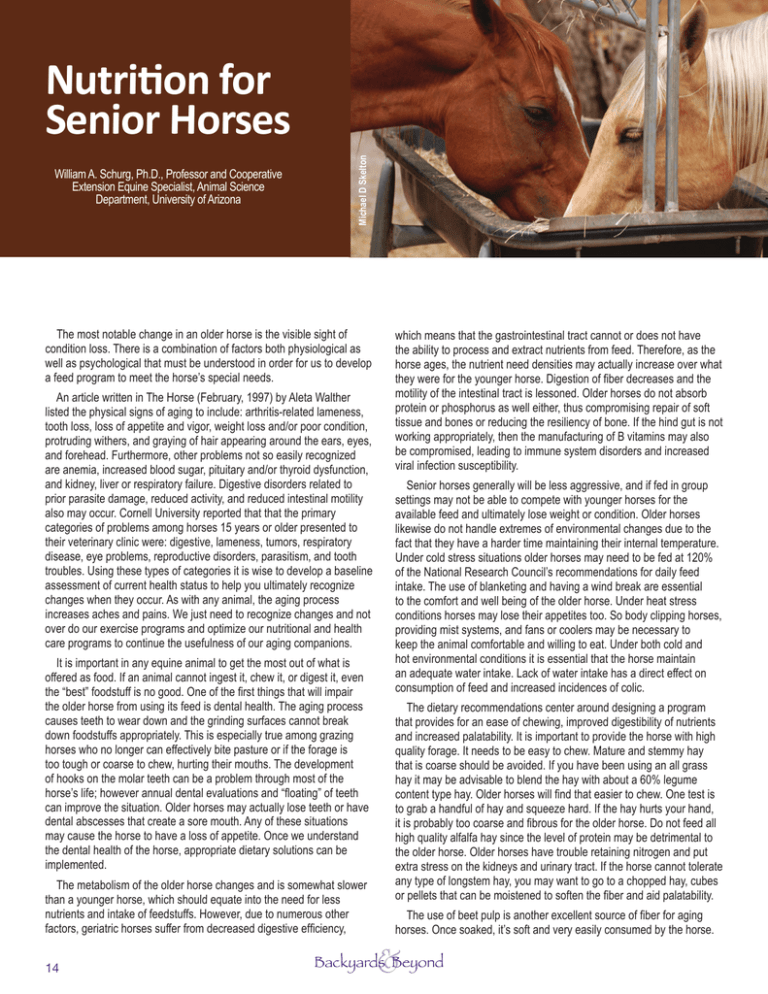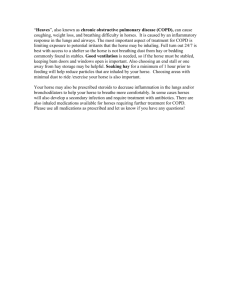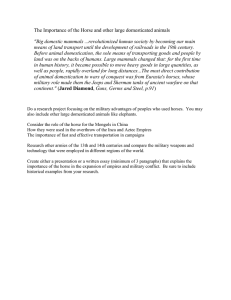The most notable change in an older horse is the... which means that the gastrointestinal tract cannot or does not...
advertisement

William A. Schurg, Ph.D., Professor and Cooperative Extension Equine Specialist, Animal Science Department, University of Arizona Michael D Skelton Nutrition for Senior Horses The most notable change in an older horse is the visible sight of condition loss. There is a combination of factors both physiological as well as psychological that must be understood in order for us to develop a feed program to meet the horse’s special needs. An article written in The Horse (February, 1997) by Aleta Walther listed the physical signs of aging to include: arthritis-related lameness, tooth loss, loss of appetite and vigor, weight loss and/or poor condition, protruding withers, and graying of hair appearing around the ears, eyes, and forehead. Furthermore, other problems not so easily recognized are anemia, increased blood sugar, pituitary and/or thyroid dysfunction, and kidney, liver or respiratory failure. Digestive disorders related to prior parasite damage, reduced activity, and reduced intestinal motility also may occur. Cornell University reported that that the primary categories of problems among horses 15 years or older presented to their veterinary clinic were: digestive, lameness, tumors, respiratory disease, eye problems, reproductive disorders, parasitism, and tooth troubles. Using these types of categories it is wise to develop a baseline assessment of current health status to help you ultimately recognize changes when they occur. As with any animal, the aging process increases aches and pains. We just need to recognize changes and not over do our exercise programs and optimize our nutritional and health care programs to continue the usefulness of our aging companions. It is important in any equine animal to get the most out of what is offered as food. If an animal cannot ingest it, chew it, or digest it, even the “best” foodstuff is no good. One of the first things that will impair the older horse from using its feed is dental health. The aging process causes teeth to wear down and the grinding surfaces cannot break down foodstuffs appropriately. This is especially true among grazing horses who no longer can effectively bite pasture or if the forage is too tough or coarse to chew, hurting their mouths. The development of hooks on the molar teeth can be a problem through most of the horse’s life; however annual dental evaluations and “floating” of teeth can improve the situation. Older horses may actually lose teeth or have dental abscesses that create a sore mouth. Any of these situations may cause the horse to have a loss of appetite. Once we understand the dental health of the horse, appropriate dietary solutions can be implemented. The metabolism of the older horse changes and is somewhat slower than a younger horse, which should equate into the need for less nutrients and intake of feedstuffs. However, due to numerous other factors, geriatric horses suffer from decreased digestive efficiency, 14 which means that the gastrointestinal tract cannot or does not have the ability to process and extract nutrients from feed. Therefore, as the horse ages, the nutrient need densities may actually increase over what they were for the younger horse. Digestion of fiber decreases and the motility of the intestinal tract is lessoned. Older horses do not absorb protein or phosphorus as well either, thus compromising repair of soft tissue and bones or reducing the resiliency of bone. If the hind gut is not working appropriately, then the manufacturing of B vitamins may also be compromised, leading to immune system disorders and increased viral infection susceptibility. Senior horses generally will be less aggressive, and if fed in group settings may not be able to compete with younger horses for the available feed and ultimately lose weight or condition. Older horses likewise do not handle extremes of environmental changes due to the fact that they have a harder time maintaining their internal temperature. Under cold stress situations older horses may need to be fed at 120% of the National Research Council’s recommendations for daily feed intake. The use of blanketing and having a wind break are essential to the comfort and well being of the older horse. Under heat stress conditions horses may lose their appetites too. So body clipping horses, providing mist systems, and fans or coolers may be necessary to keep the animal comfortable and willing to eat. Under both cold and hot environmental conditions it is essential that the horse maintain an adequate water intake. Lack of water intake has a direct effect on consumption of feed and increased incidences of colic. The dietary recommendations center around designing a program that provides for an ease of chewing, improved digestibility of nutrients and increased palatability. It is important to provide the horse with high quality forage. It needs to be easy to chew. Mature and stemmy hay that is coarse should be avoided. If you have been using an all grass hay it may be advisable to blend the hay with about a 60% legume content type hay. Older horses will find that easier to chew. One test is to grab a handful of hay and squeeze hard. If the hay hurts your hand, it is probably too coarse and fibrous for the older horse. Do not feed all high quality alfalfa hay since the level of protein may be detrimental to the older horse. Older horses have trouble retaining nitrogen and put extra stress on the kidneys and urinary tract. If the horse cannot tolerate any type of longstem hay, you may want to go to a chopped hay, cubes or pellets that can be moistened to soften the fiber and aid palatability. The use of beet pulp is another excellent source of fiber for aging horses. Once soaked, it’s soft and very easily consumed by the horse. & Backyards Beyond Beet pulp is an excellent source of digestible nutrients and a very good source of calcium. Whole grains may not be able to be broken down by the older horse, therefore rolling, steam flaking, extruding and/or pelleting may be appropriate actions. Soaking grains in warm water aids in palatability and will provide the older horse additional water intake. The older horse has needs very similar to the weanling in terms of protein quality and mineral nutrition. Many feed companies have developed the “Senior” lines of feeds that have a softer textured pelleted format which improves palatability. The use of added dietary fat in the form of corn oil or rice bran appears to be a way to increase energy density and improve palatability. Top dressing vegetable oil to a level of up to two cups per day (spread over several feedings a day) is an excellent way to improve intake. Many feeds are formulated with added fat. Look on the feed label and see that the feed tag shows at least 5-8% fat level. If you feed rice bran as a source of fat make sure that it has added calcium since rice bran is very high in phosphorus. If your hay quality is questionable, then the use of the complete senior diet may be an option. If you need to add additional protein to the horse’s diet, the use of soybean meal will provide additional high quality protein and only needs to be added in very small amounts. The use of brewer’s yeast and some of the new probiotics also may be supplemental additives that will be beneficial to the older horse. Older equines may also benefit from additions of vitamin C and the B complex vitamins since they are not capable of manufacturing their own within the hind gut. Horse owners need to be willing to try many different things to find the right mix for the older horse. No one feed program will be specifically beneficial to all horses. Remember each horse is an individual. If your horse becomes a finicky eater, be willing to modify his diet. Feed smaller meals more often, be sure that he is drinking plenty of clean fresh water, and find the right presentation of feedstuffs to interest him. We can manage the feed and the environmental aspects to allow the horse to be healthy and useful for many years to come. & Order Form Backyards Beyond cals.arizona.edu/backyards/ Name__________________________________________ Name__________________________________________ Company_______________________________________ Company_______________________________________ Address________________________________________ City____________________________________________ Ship to Bill to RURAL LIVING IN ARIZONA Address________________________________________ City____________________________________________ State______________________ Zip Code___________ State______________________ Zip Code___________ e-mail__________________________________________ e-mail__________________________________________ Publication Price Quantity Total Enclosed $10.00 Yearly subscription: Backyards & Beyond: Rural Living in Arizona Payment VISA/Master Card _______________________________________________ Card Number _______________________________________________ Expiration Date _______________________________________________ Signature Summer 2010 Check or money order enclosed, payable to The University of Arizona Mail this form and your check or credit card information to: CALSmart University of Arizona Office 520-318-7275 4101 N. Campbell Ave. Fax 520-795-8508 Bldg. 2006B Toll-free 877-763-5315 Tucson, AZ 85719 calsmart@ag.arizona.edu 15








